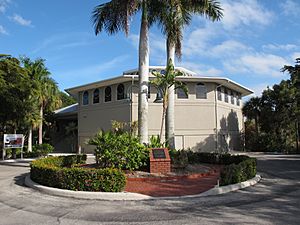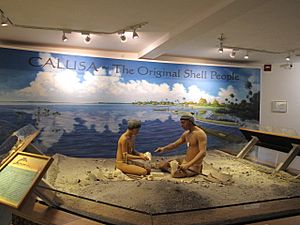Bailey-Matthews National Shell Museum facts for kids
| Lua error in Module:Location_map at line 420: attempt to index field 'wikibase' (a nil value). | |
| Former name | Bailey-Matthews Shell Museum, Bailey-Matthews National Shell Museum |
|---|---|
| Established | 1995 |
| Location | 3075 Sanibel-Captiva Road, Sanibel, Florida, 33957, U.S. |
| Type | Malacology and Conchology |
| Accreditation | American Alliance of Museums, 2010 Association of Zoos and Aquariums, 2022 |
| Architect | George "Tutts" Tuttle Jr. |

The Bailey-Matthews National Shell Museum & Aquarium is a super cool place in Sanibel, Florida. It's a museum and aquarium all about seashells! You can learn about every part of shells, including how they are formed and how people have used them throughout history. It's also a place where scientists study shells and the animals that make them.
This museum opened its doors in 1995. It helps scientists, students, and shell fans from all over the world. They especially focus on shells from the Gulf of Mexico and Florida. The museum is officially recognized by the American Alliance of Museums. It was damaged by Hurricane Ian but reopened in February 2023, ready for visitors again!
Where Do All These Shells Come From?
The museum has amazing shells from all over the world. Many of the shells you'll see are from Florida. A lot of them come from Sanibel and Captiva islands themselves. That's because Sanibel Island is one of the best places in the world to find seashells! It's as famous for shells as places like Jeffreys Bay in Africa.
The museum also has a special collection of shells from the Pacific Ocean. These include beautiful cowries and cones. They were given to the museum by the actor Raymond Burr. He owned an island in the Fijis and helped raise money to build the museum.
What Can You Do at the Museum?
The museum has 34 different exhibits to explore. They also offer fun public programs and lots of information. The museum works with schools and research groups around the world. They have special areas for visiting scientists and students to study shells.
Experts in marine science and biology use the museum's resources. The museum also has a field trip program for 4th-grade students from Lee County schools.
The museum works with many other organizations. These include the Smithsonian Institution and the Florida Museum of Natural History. They also partner with local libraries, schools, and shell clubs.
You can even search databases on the museum's website. These databases have information about shells from the museum and from Southwest Florida. The museum also leads guided beach walks. On these walks, museum experts help you find shells and teach you about the animals that live inside them.
How the Museum Started
The Bailey-Matthews National Shell Museum began with a special gift. In 1990, three brothers, John, Francis, and Sam Bailey, donated the land. They did this to honor their parents. A famous shell scientist, R. Tucker Abbott, helped start the museum. The building was designed by an architect named George "Tutts" Tuttle Jr.

In 1993, the museum started raising money to build. They got a loan from a bank and a grant from the State of Florida. The museum officially opened on November 18, 1995. In 1996, another shell scientist, José H. Leal, became the director. In 1997, the museum started publishing The Nautilus. This is one of the oldest English-language science journals about shells in the world!
By 1999, the museum had paid off its original bank loan. In 2000, they started a special fund to help the museum grow. The museum has also been reviewed by important organizations to make sure it's doing a great job. In 2014, the museum changed its name to "Bailey-Matthews National Shell Museum." Then, in 2019, it became the "Bailey-Matthews Shell Museum & Aquarium" to show it also has an aquarium!

